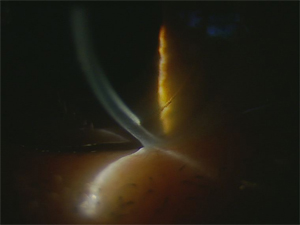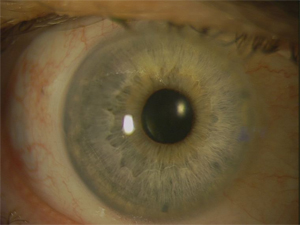View: 10TV News Report
Descemet’s Stripping Endothelial Keratoplasty (DSEK) is a cornea-sparing transplant procedure, brought to Central Ohio in 2006 by Dr Erdey, indicated for patients without corneal scarring and with disease limited to the inner corneal layer (endothelium) such as Fuchs’ Endothelial Dystrophy or Pseudophakic Bullous Keratopathy.
| [kml_flashembed movie=”https://www.icanseeclearly.com/wp-content/uploads/2011/05/fig6a.swf” height=”180″ width=”450″ /] |
| DSEK: Cross Section of Cornea showing partial thickness donor adherent to undersurface of a patient’s cornea |
Only the inner cornea layer is transplanted, leaving the patient’s cornea mostly intact. A small scleral incision is made and few sutures are required. The cornea heals very quickly and is less susceptible to injury or rupture as compared to standard PK. Visual recovery is much faster since the cornea’s original curvature is essentially unchanged resulting in little refractive shift. In contrast, after standard PK, patients often experience large changes in the amount of nearsightedness, farsightedness, and astigmatism. We no longer recommend traditional PK for suitable candidates with Fuchs’ Endothelial Dystrophy or Pseudophakic Bullous Keratopathy.
In 2010, Dr Erdey became the first in Ohio to routinely perform newer variations of DSEK called Descemet’s Memebrane Endothelial Keraoplasty (DMEK) and Descemet’s Membrane Automated Endothelial Keraotplasty (DMAEK). These variations require specially prepared cornea tissue from highly trained eye bank technicians. In 2011, with Dr. Erdey’s encouragement, Central Ohio Lions Eye Bank became only the second eye bank in the U.S. to offer this preparation! Drs. Erdey and Kaswinkel continue to refine, and currently prefer DMEK or DMAEK over DSEK in most cases, because of the higher probability of superior visual results. Also, In a recent study, the incidence of cornea rejection two years after DMEK surgery was 15x less compared to DSEK and 20x less compared to PK.
 |
| Case 1: Cornea after DSEK: donor disc applied to inner cornea surface adds thickness due to retained donor stroma (note step-up – opaque wedge). Cornea transparency is restored. |
 |
| Case 2: Cornea after DMEK: Cornea transparency and anatomy is restored to natural condition without adding additional thickness as in DSEK. |
